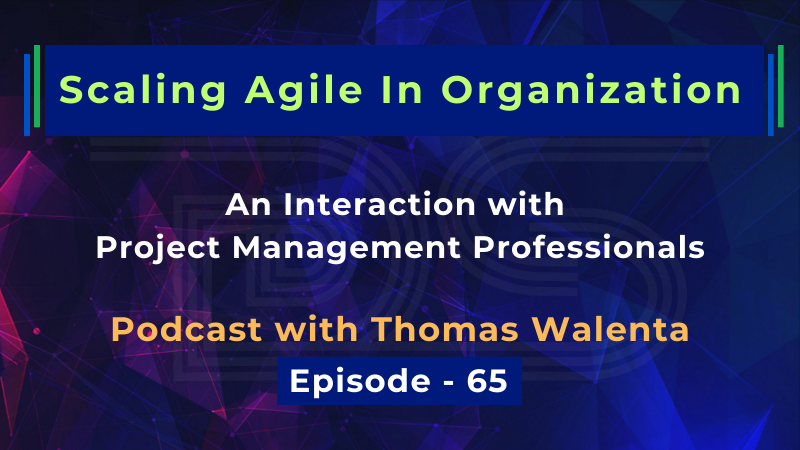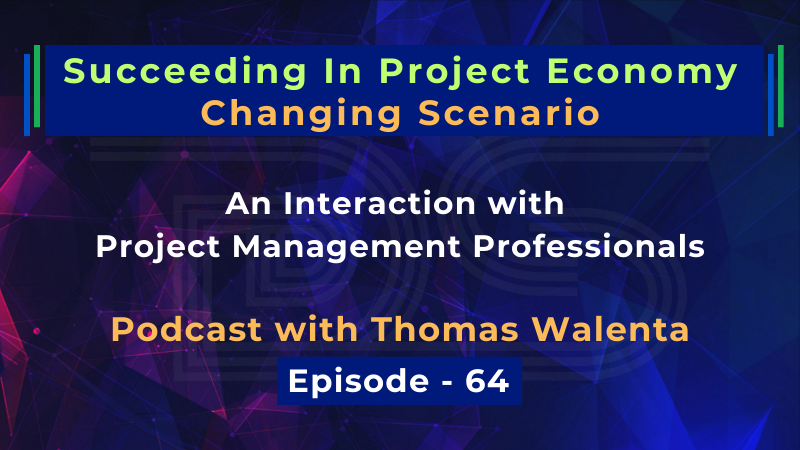
by DharamCW | May 29, 2024 | Program Management
Implication Of Organizational Capacity On Project Delivery | Justin Buckwalter | Dharam | Episode 17
Exploring the critical link between organizational capacity and project success, Episode 17 features insightful discussions on key aspects:
1. How does the scalability of organizational capacity influence project adaptability in dynamic business environments?
2. How can organizational capacity influence project risk assessment and mitigation plans?
3. What strategies enhance an organization’s capacity for handling simultaneous or complex projects, and what unique challenges differentiate managing these projects from others?
4. What challenges arise when scaling project delivery capabilities to meet increasing organizational demands?
5. Discuss the influence of stakeholder engagement and communication on leveraging organizational capacity for project success.
6. How does organizational capacity affect adaptability and responsiveness to changing project requirements or unexpected obstacles?
7. How can organizational capacity be measured and improved to optimize project delivery outcomes?
Stay informed and enhance your project management skills by delving into these crucial insights.
🚀 Seize the opportunity to Elevate Your Project Management Career:
– Register for my upcoming PMI Certification Success Story Webinars: https://bit.ly/4aVhrd6 / https://bit.ly/3QeVhKF
– Book an obligation-free consultation session on Project management Career, training, and certifications: http://talktodharam.com
– Discover training offers and certification discounts: https://bit.ly/3jWVepD
– Stay updated with our Q&A series and certification success stories by subscribing to the vCare Project Management YouTube channel at https://bit.ly/2YF0wJl
– Follow my podcasts and interviews with Project Management Experts on YouTube at https://bit.ly/2NDY8wd

by DharamCW | May 25, 2024 | Agile and Scrum Practices
Scaling Agile In Organization | Thomas Walenta | Dharam Singh | Episode 65
Join Thomas Walenta and myself as we delve into critical aspects of large-scale agile transformations. Learn about the role of leadership in fostering an agile culture, common networking mistakes at Agile meetups, managing technological risks, addressing integration challenges, preventing technical debt, and tracking success with essential KPIs and metrics.
– Why do large-scale agile transformations fail?
– Can you explain the role of leadership in fostering an agile culture during the scaling process?
– What are the most common mistakes when networking at Agile meetups?
– How do project managers manage technological obsolescence risk with Agile methodologies?
– How do you address integration challenges when scaling Agile across multiple teams and departments with different technologies and toolsets?
– What techniques can be employed to prevent the accumulation of technical debt in a rapidly evolving Agile setting?
– What key performance indicators (KPIs) and metrics are essential for tracking the success and efficiency of Agile practices at scale?
– How can organizations implement effective monitoring systems to identify and address issues quickly in a large-scale agile environment?
🚀 Seize the opportunity to Elevate Your Project Management Career:
– Register for my upcoming PMI Certification Success Story Webinars: https://bit.ly/4aVhrd6 / https://bit.ly/3QeVhKF
– Book an obligation-free consultation session on Project management Career, training, and certifications: http://talktodharam.com
– Discover training offers and certification discounts: https://bit.ly/3jWVepD
– Stay updated with our Q&A series and certification success stories by subscribing to the vCare Project Management YouTube channel at https://bit.ly/2YF0wJl
– Follow my podcasts and interviews with Project Management Experts on YouTube at https://bit.ly/2NDY8wd

by DharamCW | May 21, 2024 | Project Management
Rethinking How To Handle Multiple Projects | Justin Buckwalter | Dharam Singh | Episode 16
In this insightful episode, we dive deep into effective strategies for managing multiple projects simultaneously. Join us as we discuss:
🔹 Prioritization, Communication, and KPIs: Master the fundamentals of project management.
🔹 Balancing Multiple Demands: Learn how to prevent burnout while juggling several projects.
🔹 Addressing Stakeholder Differences: Navigate fears and expectations among clients, top management, and project managers.
🔹 Cross-Project Collaboration: Discover best practices and promote a culture of continuous improvement.
🔹 Safe Expression and Participation: Ensure every team member can voice their opinions for project enhancement.
🔹 Managing Complex Client Expectations: Tackle challenges in intricate project environments.
🚀 Seize the opportunity to Elevate Your Project Management Career:
– Register for my upcoming PMI Certification Success Story Webinars: https://bit.ly/4aVhrd6 / https://bit.ly/3QeVhKF
– Book an obligation-free consultation session on Project management Career, training, and certifications: http://talktodharam.com
– Discover training offers and certification discounts: https://bit.ly/3jWVepD
– Stay updated with our Q&A series and certification success stories by subscribing to the vCare Project Management YouTube channel at https://bit.ly/2YF0wJl
– Follow my podcasts and interviews with Project Management Experts on YouTube at https://bit.ly/2NDY8wd

by DharamCW | May 17, 2024 | Professional Development Webinars
Good Governance and Decision-Making | Dan Dilov | 1 PDU | vCare PgMP Success StoryWCs_zdWOwZk
Join me for an upcoming webinar featuring Dan Dilov, Senior Project/Program Manager, at 7even Stars Ltd in Ottawa, Ontario, Canada. Dan is an accomplished IT project and program management professional with extensive experience and certifications in PgMP, PMP, and ITIL.
The webinar will cover five essential topics, including:
– Involving Stakeholders in Decision-Making: Pathways to Good Governance
– Decision-Making Dynamics in Contractual Projects: Balancing Interests and Challenges
– Steering IT Transformations: The Critical Role of Governance in Complex Projects
– Leadership Influence: Shaping and Sustaining Good Governance in Projects
– Navigating Pitfalls: Unpacking the Risks and Failures in Governance Practices
🔗 Reserve your spot now: https://bit.ly/4aVhrd6
Take advantage of this free webinar and gain Dan’s valuable industry and certification insights. As an added benefit, attendees will receive 1 PDU for the session.
Session Date & Time: Friday, 31st May 2024
09:00 AM – 10:00 AM (PDT) / 10:00 AM – 11:00 AM (MDT) / 11:00 AM – 12:00 PM (CDT) / 12:00 PM – 01:00 PM (EDT) / 01:00 PM – 02:00 PM (BRT) / 05:00 PM – 06:00 PM (BST) / 06:00 PM – 07:00 PM (CEST) / 07:00 PM – 08:00 PM (AST) / 08:00 PM – 09:00 PM (GST) / 09:30 PM – 10:30 PM (IST)
🚀 Elevate Your Project Management Career:
– Book an obligation-free consultation session on Project Management Career, training, and certifications: http://talktodharam.com
– Discover training offers and certification discounts: https://bit.ly/3jWVepD
– Stay updated with our Q&A series and certification success stories by subscribing to the vCare Project Management YouTube channel at https://bit.ly/2YF0wJl
– Follow my podcasts and interviews with Project Management Experts on YouTube at https://bit.ly/2NDY8wd

by DharamCW | May 16, 2024 | Project Management
Succeeding In Project Economy – Changing Scenario
Join us for Episode 64 in our insightful webinar series with Thomas Walenta. This episode dives into the dynamic landscape of the Project Economy, offering crucial insights for senior project, program, and portfolio management professionals.
Key topics discussed include:
+ Gig Economy Disruption: Discover the significant challenges and exciting opportunities the Project Economy brings.
+ Reshaping Traditional Structures: Understand how the Project Economy transforms business operations.
+ Cross-Functional Teams: Learn about potential roadblocks and strategies to manage conflicts between technical and non-technical teams.
+ Environmental Responsibilities: Explore how emerging social and environmental responsibilities influence project priorities.
+ Projectification: Discuss its impact on organizational strategies and value creation.
+ Workforce Models Transformation: See how the Project Economy changes workforce dynamics.
+ Agile Mindset: Learn how adopting an agile mindset helps navigate uncertainty in project-driven environments.
+ Project Success Assessment: Learn how assessing project success enhances ongoing project delivery.
🚀 Embrace the chance to Advance Your Project Management Career:
– Register for my upcoming PgMP/PfMP Success Story Webinars: https://bit.ly/4aVhrd6 / https://bit.ly/4aycVBj
– Book an obligation-free consultation session on Project management Career, training, and certifications. Get personalized advice and guidance tailored to your career goals: http://talktodharam.com
– Discover training offers and certification discounts: https://bit.ly/3jWVepD
– Stay updated with our Q&A series and certification success stories by subscribing to the vCare Project Management YouTube channel at https://bit.ly/2YF0wJl
– Follow my podcasts and interviews with Project Management Experts on YouTube at https://bit.ly/2NDY8wd










Recent Comments